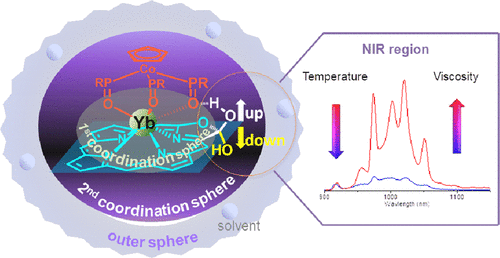当前位置:
X-MOL 学术
›
Inorg. Chem.
›
论文详情
Our official English website, www.x-mol.net, welcomes your
feedback! (Note: you will need to create a separate account there.)
Design of Near-Infrared Luminescent Lanthanide Complexes Sensitive to Environmental Stimulus through Rationally Tuning the Secondary Coordination Sphere
Inorganic Chemistry ( IF 4.3 ) Pub Date : 2018-01-16 00:00:00 , DOI: 10.1021/acs.inorgchem.7b02750 Yingying Ning 1 , Yi-Wei Liu 1 , Yin-Shan Meng 1 , Jun-Long Zhang 1
Inorganic Chemistry ( IF 4.3 ) Pub Date : 2018-01-16 00:00:00 , DOI: 10.1021/acs.inorgchem.7b02750 Yingying Ning 1 , Yi-Wei Liu 1 , Yin-Shan Meng 1 , Jun-Long Zhang 1
Affiliation

|
The design of near-infrared (NIR) emissive lanthanide (Ln) complexes sensitive to external stimulus is fundamentally important for the practical application of Ln materials. Because NIR emission from Ln is extremely sensitive to X–H (X = C, N and O) bond vibration, we herein report to harness the secondary coordination sphere to design NIR luminescent lanthanide sensors. Toward this goal, we designed and synthesized two isomeric [(η5-C5H5)Co{(D3CO)2P = O}3]-Yb(III)-7,8,12,13,17,18-hexafluoro-5,10,15,20-tetrakis(pentafluorophenyl)porpholactol NIR emitters, Yb-up and Yb-down, based on the stereoisomerism of porphyrin peripheral β-hydroxyl group. Yb-up, in which β-OH is at the same side of Yb(III) center, can form an intramolecular hydrogen bond with the axial Kläui ligand, whereas Yb-down cannot because its β-OH is opposite to Yb(III) center. X-ray crystal structures and photophysical studies suggested that the intramolecular hydrogen bond plays important roles on the NIR luminescence of ytterbium(III), which shortens the distance between β-OH and Yb(III) and facilitates the nonradiative deactivation of Ln excited state. Importantly, Yb-up/down were demonstrated to be highly sensitive toward temperature and viscosity. The PMMA polymer using Yb-up as the dopant NIR emitter showed thermosensitivity up to 6.0% °C–1 in the wide temperature range of 77–400 K, higher than that of Yb-down (3.8% °C–1). These complexes were also explored as the first NIR viscosity sensor, revealing their potential applications as optical sensors without visible light interference. This work demonstrates the importance of secondary coordination sphere on designing NIR Ln luminescent functional materials.
中文翻译:

通过合理调整次级配位域设计对环境刺激敏感的近红外发光镧系配合物
对外部刺激敏感的近红外(NIR)发射镧系(Ln)配合物的设计对于Ln材料的实际应用至关重要。由于Ln的NIR发射对X–H(X = C,N和O)键振动极为敏感,因此我们在此报告利用二级配位球设计NIR发光镧系元素传感器。为了实现这一目标,我们设计并合成两种异构体[(η 5 -C 5 H ^ 5)有限{(d 3 CO)2 P = O,} 3 ] -Yb(III)-7,8,12,13,17, 18-六氟-5,10,15,20-四(五氟苯基)-半乳糖醇近红外发射体,Yb-up和Yb-down,基于卟啉外围β-羟基的立体异构。Yb-up可以与轴向Kläui配体形成分子内氢键,其中β-OH在Yb(III)中心的同一侧,而Yb-down则不能,因为其β-OH与Yb(III)相对中央。X射线晶体结构和光物理研究表明,分子内氢键在(III)的NIR发光中起重要作用,这缩短了β-OH和Yb(III)之间的距离,并促进了Ln激发态的非辐射失活。重要的是,Yb-up / down被证明对温度和粘度高度敏感。使用Yb-up的PMMA聚合物因为掺杂剂NIR发射器在77–400 K的宽温度范围内显示高达6.0%°C –1的热敏性,高于Yb-down(3.8%°C –1)的热敏性。这些配合物也被作为第一个近红外粘度传感器进行了探索,揭示了它们作为无可见光干扰的光学传感器的潜在应用。这项工作证明了二级配位领域对设计NIR Ln发光功能材料的重要性。
更新日期:2018-01-16
中文翻译:

通过合理调整次级配位域设计对环境刺激敏感的近红外发光镧系配合物
对外部刺激敏感的近红外(NIR)发射镧系(Ln)配合物的设计对于Ln材料的实际应用至关重要。由于Ln的NIR发射对X–H(X = C,N和O)键振动极为敏感,因此我们在此报告利用二级配位球设计NIR发光镧系元素传感器。为了实现这一目标,我们设计并合成两种异构体[(η 5 -C 5 H ^ 5)有限{(d 3 CO)2 P = O,} 3 ] -Yb(III)-7,8,12,13,17, 18-六氟-5,10,15,20-四(五氟苯基)-半乳糖醇近红外发射体,Yb-up和Yb-down,基于卟啉外围β-羟基的立体异构。Yb-up可以与轴向Kläui配体形成分子内氢键,其中β-OH在Yb(III)中心的同一侧,而Yb-down则不能,因为其β-OH与Yb(III)相对中央。X射线晶体结构和光物理研究表明,分子内氢键在(III)的NIR发光中起重要作用,这缩短了β-OH和Yb(III)之间的距离,并促进了Ln激发态的非辐射失活。重要的是,Yb-up / down被证明对温度和粘度高度敏感。使用Yb-up的PMMA聚合物因为掺杂剂NIR发射器在77–400 K的宽温度范围内显示高达6.0%°C –1的热敏性,高于Yb-down(3.8%°C –1)的热敏性。这些配合物也被作为第一个近红外粘度传感器进行了探索,揭示了它们作为无可见光干扰的光学传感器的潜在应用。这项工作证明了二级配位领域对设计NIR Ln发光功能材料的重要性。











































 京公网安备 11010802027423号
京公网安备 11010802027423号